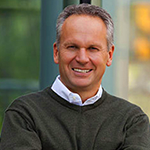IoT WebTalk: How Can C-V2X Create an Environment that Improves Quality of Life for Everyone?
In this IoT WebTalk, industry experts from 5GAA, BMW, Tech Mahindra, Vodafone and the GSMA discuss how C-V2X (Cellular Vehicle-to-Everything) can enable more efficient driving and deliver improved road safety for all traffic participants.
- Welcome and Introduction (0:00)
Amaia White, IoT Programme Manager, GSMA - Cellular-Vehicle-to-Everything (C-V2X): Today and Next Steps (02:20)
Maxime Flament, CTO, 5GAA - Building Partnerships to Enable Connected Mobility (13:00)
Luke Ibbetson, Head of Group R&D, Vodafone - Connected and Automated Driving – Cellular Ecosystem Approach (19:14)
Joachim Goethel, Senior Manager Project 5G Alliance, BMW
- Enabling the C-V2X Ecosystem (27:13)
Steve Schwinke, Global Head of Connected Vehicles, Tech Mahindra - Panel and Q&A with all speakers (32:27)
Speakers

Maxime Flament
CTO, 5GAA
Dr. Flament represents 5GAA, the global cross-industry association for the development of connected and automated cars, where he works as Chief Technology Officer since April 2018. Maxime was working previously as Head of Department for Connected & Automated Driving (CAD) at ERTICO – ITS Europe. Maxime holds a PhD and MSc from Chalmers Technical University, Sweden and an “Ingénieur Civil” degree from the Free university of Brussels. He also was visiting researcher at Stanford University, CA, USA.

Joachim Göthel
Senior Manager Project 5G Alliance, BMW
Dr. Joachim Göthel is Senior Manager Project 5G Alliance in BMW Group´s Connected Company Development. In this position he holds the overall responsibility for the coordination of standardization and future integration of 5G mobile communication technology into vehicle platforms of BMW Group. He has been with BMW since 1996. Since then he has held various managing positions in the areas of electronics and system integration at BMW including power supply systems and electrification based on Li-Ion technology. Moreover, he has gathered many years of managing experience in communication systems and telematics until he took over the project lead of 5G Alliance in 2017.
Dr. Joachim Göthel received his Master degree in Electrical Engineering/Technical Electro Physics from the Technical University of Munich. He did his PhD at the Max-Planck-Institute for Quantum Optics in Garching, Germany.

Steve Schwinke
VP Customer Engagement, Sibros
Steve Schwinke is Vice President of Customer Engagement at Sibros, working closely with OEMs and Tier One suppliers to accelerate their connected vehicle solutions. He is a pioneer in the industry having spent 22 years at General Motors as an original Executive member of the OnStar team designing their first 3-button system, developing and launching numerous industry first connected vehicle products and services. He is a recognized expert in connected vehicle technology having served on the Executive Board of Directors for the Telecommunications Industry Association and has been awarded 34 patents involving telecommunications, telematics and navigation. Steve holds a Bachelor of Science in Electrical Engineering from the University of Michigan and a Masters of Science in Wireless Communication Systems from Santa Clara University.

Luke Ibbetson
Head of Group R&D, Vodafone
Luke Ibbetson has been with Vodafone since 1996 and currently leads the Vodafone Group Research and Development organisation, responsible for all aspects of future research including trials of emerging / disruptive technologies, new industry partnerships and the creation of future revenue engines through advanced technology. Luke is an active participant in Industry Initiatives including 5GAA (Board member), Chairman of the NGMN 5G Board Committee, Advisory Board for UK TechWorks, and Board member for several venture backed new technology companies in which Vodafone has invested. Luke is a proud pioneer of Narrow Band IoT technology and currently shaping Vodafone’s thinking on 6G. Luke is a passionate supporter of innovative thinking, helping to create new opportunities for technology to change lives and society for the better.

Dr Shane Rooney
Senior Technical Director, GSMA
Shane Rooney is a Senior Technical Director at the GSMA, leading activities in IoT and bringing together strategies and synergies across industry verticals and wider IoT ecosystems. Shane had previously led the GSMA’s initiative in developing mobile solutions in Smart Cities and collaborating with cities like Barcelona, Dubai and Shanghai. His team has developed a wider range of Smart City Indicators, Case Studies and Business Cases demonstrating the importance of mobile technology. His team also have developed enablers in IoT Security and embedded SIM. He has led the launch of the Cellular LPWA Networks Technology (LTE-M and NB-IoT) initiative globally and is now promoting Cellular V2X technology. Previously he has been a Group Vice President with Etisalat, developing solutions for Energy, Security and Transport IoT solutions for Middle East, Africa and Asia. Before that he has worked with other Mobile Operators, Vodafone, Hutchison and 3 UK as well as launching and divesting of his own M2M company. Shane pioneered early telematics and connected car solutions for Ford Motor Company in the USA and Europe. He has extensive Global experience. He holds a PhD in Communications Systems specialising in Location Based Services and studied Business Marketing at IMD Switzerland.

Amaia White
IoT Programme Manager, GSMA
Amaia is the Senior Project Manager for the GSMA’s Mobile IoT Initiative, which is supporting the industry in delivering commercial LPWA solutions in licensed spectrum (Mobile IoT). Leading a team of project managers, she runs and coordinates the delivery of numerous projects and industry engagement activities within the initiative that are aimed at accelerating the commercial availability of new solutions and the accelerated growth of the wider ecosystem. Prior to this Amaia has managed a number of projects both within Mobile IoT, and the Technology and Programme Services teams at the GSMA. She holds a BA in Linguistics from Leeds University and is a Prince2 qualified Project Manager.
Q&A
Maxime Flament, 5GAA: We are not talking about many different options; 5GAA is advocating for only one way forward:
Today: deploy LTE-V2X, this includes long range connection to cloud services via LTE and short-range direct communication using the 5.9GHz band.
Tomorrow: deploy 5G-V2X, including the above and complemented by the 5G New Radio for advanced driving services.
Steve Schwinke, Tech Mahindra: I don’t believe the Uu interface alone can enable V2X. However, I do believe WSPs will deploy RSUs along with smaller cells to improve overall network performance. To realize the full ecosystem of services, stand-alone RSUs will be deployed as additional “street furniture” starting with traffic lights broadcast SPaT data. As the cost comes down and networked solutions are deployed, they can be located almost anywhere.
Luke Ibbetson, Vodafone: First, to be clear, we’re commenting only on the specific topic of C-V2X. There are lots of other security considerations on the broader topic of connected and/or autonomous vehicles, which we don’t address here.
The primary concern that C-V2X needs to address is privacy. Vehicles will be continually broadcasting safety messages, reporting their location, velocity, road conditions etc., and naturally there is a concern that these could be used for automated tracking. C-V2X systems address this by providing all vehicles with a large and regularly changing set of aliases, so in effect the messages sent by a single vehicle appear to come from different anonymous identities, and it is hard to relate messages to each other or to any recognisable or permanent identity. The cellular connection to vehicles makes it easy to update a vehicle’s set of aliases regularly.
Another question that’s often asked is: what if people could spoof messages, or block genuine messages? Could someone cause traffic chaos by sending out false reports, or by preventing true reports from being received? There are two answers to this question:
First, it is important to realise that C-V2X messages are one of many inputs that vehicle safety or automation systems take into account. The decision making algorithms in vehicles weigh up lots of inputs, and make sensible, weighted, risk-limiting decisions based on all available data; one misleading input, or one missing data point, will not cause a vehicle to go haywire.
Second, C-V2X messages are cryptographically signed and verified, so that arbitrary attackers can’t sit by the side of the road sending out false messages – those would just be rejected. 5GAA is also working to produce guidance on misbehaviour detection, so that genuine vehicles that are malfunctioning and sending out wrong (but correctly signed) messages can be identified and have their ability to sign future messages revoked.
Joachim Göthel, BMW: On-board sensors are always required as a fallback solution for safety-critical functionality in automotive use cases. At the other end, there are strong requirements for data and information to be transmitted wirelessly in order to expand the limited range of on-board sensors. If rules of so-called automotive functional safety (ASIL) standards are taken into account, synergies can be leveraged to efficiently integrate wireless signals into enhancements of safety concepts. Therefore, wireless will both serve comfort and safety functions, but will never replace on-board sensors entirely.
Maxime Flament, 5GAA: Unmanaged short-range communication is always a challenge, as all radios participating in the peer-to-peer communication need to be able to understand each other without any external help. If the service is using a slightly different version of the standard, it may result in incompatibilities.
The use of a “translator” is one option. To use an analogy, imagine one person speaks German, another person speaks French, and a third person translates between the two. In this case, an RSU could be listening to the 11p messages and act as a proxy for the PC5 devices.
Another option is the use of “another common language”; imagine one person speaks German, another person speaks French – and both communicate with each other in English. In this case, all radios would use the mobile network to relay their information to other relevant vehicles in the cell. (In 11p jargon, this is the hybrid option; in C-V2X jargon, it is called the Uu).
Of course, another possibility is that both people learn both languages, German and French. That would be the third alternative: dual radios on the vehicles.
We, at 5GAA, tend to prefer the service-interoperability solution using the mobile network to relay messages between PC5 and 11p vehicles – even if this may lead to lower performance in term of message latency. In this case, we recommend that safety-relevant information such as local hazard warnings (included in DEN Messages) are conveyed swiftly using an edge infrastructure.
Steve Schwinke, Tech Mahindra: I worry that critical momentum will not be achieved without the deployment of RSUs. I strongly support the deployment of safety services enabled by targeting V2V and V2P solutions. The challenge is getting all automotive manufacturers to commit to 100% deployment, and how many years after that it will take before there will be enough vehicles on the road to have a meaningful impact. RSUs and the added features will accelerate both embedded and after-market solution adoption.
Luke Ibbetson, Vodafone: Currently Road Operators have control centres with dedicated control rooms and data centres incorporating the hosting infrastructure for their road traffic control IT systems. An example is Highways England’s National Traffic Control Centre in Quinton, Birmingham and their data centre at Coleshill outside Birmingham (HE has redundant data centres). Similarly, WMCA/TfWM have a Regional Transport Co-ordination Centre (location unknown).
These centres collect and display data from the roadside systems to inform traffic control decisions and house the personnel who will oversee traffic control.
However, as data from individual vehicles starts to play a direct part in traffic monitoring and control, massive amounts of data will need to be processed more locally to avoid unnecessarily backhauling large amounts of data over long distances, and providing low latency capability for specific functions. We expect mobile operator cloud edge facilities to play a greater part in hosting some of these functions, alongside the main control centres.
The fundamental long-range use cases, e.g. V2N2V (vehicle-to-network-to-vehicle) type message forwarding, may not be operated by Road Operators at all, since their systems do not participate in message forwarding between vehicles. V2N2V types services can be operated by edge hosted service providers, perhaps comprising a combination of mobile operators and automotive manufacturers themselves. 3rd party service providers (e.g. HERE) may also participate in traffic monitoring and data processing at the edge, and their systems may contribute to the road operators’ overall monitoring solutions.
Joachim Göthel, BMW: Both existing radio standards ITS-G5 IEEE 802.11p and C-V2X 3GPP rel. 14 (LTE-V2X PC5 sidelink) are not interoperable by definition. However, elaborated use-cases based on C-ITS pilot projects are using the same type of ITS software stack (offered by many suppliers) above the individual physical layer. This technical solution will foster the exchange of relevant information of future vehicle fleets on the application level via cloud and MEC (mobile edge computing), no matter which radio module will be used individually. There are several technologies ready for deployment to cope with the respective requirements regarding latency in information exchange of specific use cases. More relaxed latencies can be fulfilled via common vehicle backend platforms, more critical requirements will be covered by methods ranging from enhancements via MEC to dual-radio road-side units which directly translate the specific radio messages to the individual recipients.
At the moment, there are no major deployments of latency-critical functions in the market. All existing products still concentrate on either V2N long-range connectivity (with millions of connected vehicles on the road already) or on informational, medium latency-critical short-range functions (ITS-G5) with a slow market ramp-up at the moment compared to the huge V2N fleet.